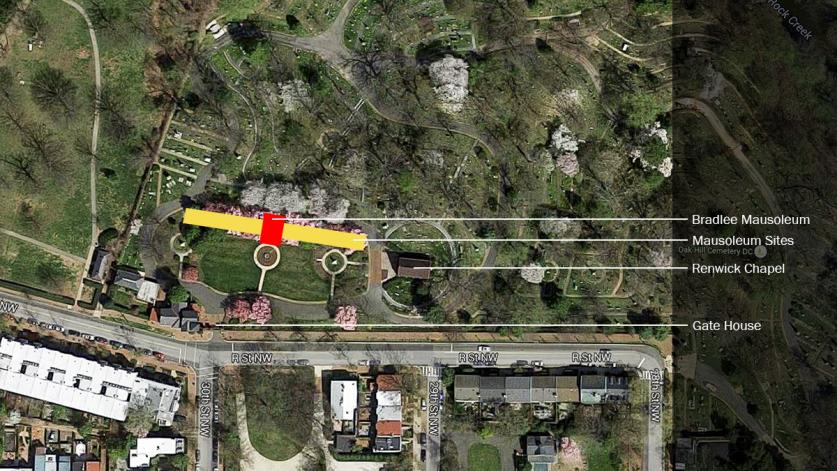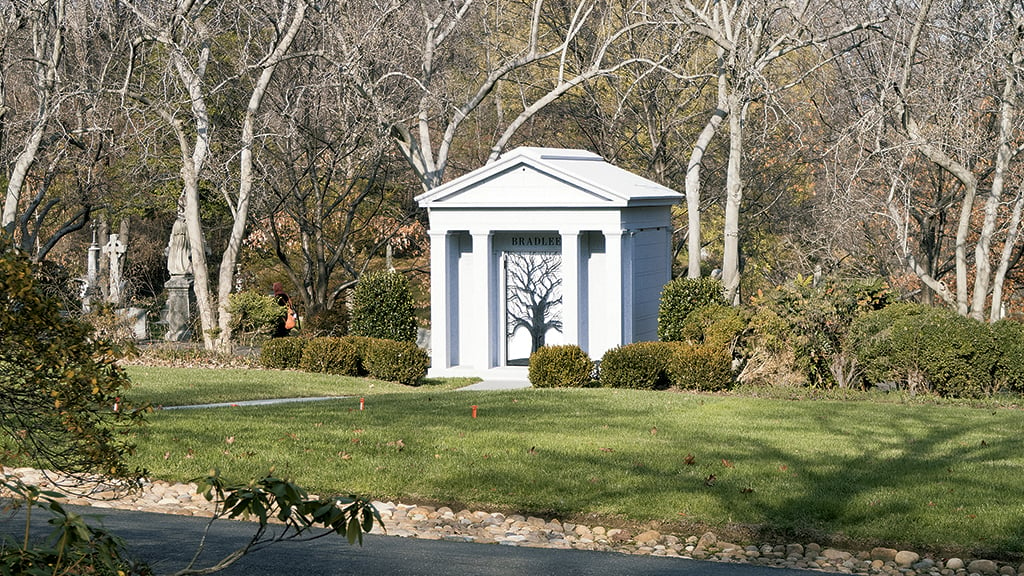Legendary former Washington Post Executive Editor Ben Bradlee died nearly two years ago, but he still hasn’t rested in peace.
Last October, a full year after his funeral at the National Cathedral, Bradlee’s remains were entombed in a neoclassical mausoleum at Georgetown’s Oak Hill cemetery, a historic burial ground containing the graves of Corcoran Gallery of Art founder William Corcoran and Post publisher Katharine Graham, as well as a 165-year-old Renwick Chapel.
As Washingtonian has previously reported, the mausoleum and complaints about its placement near the cemetery’s main entrance sparked a controversy over whether the building required a permit from the Department of Consumer and Regulatory Affairs. Although the DCRA concluded that it did in fact need a permit, which Bradlee’s widow and former Post writer Sally Quinn didn’t get, the DCRA decided that it didn’t matter, updating its policy last March to reflect that “mausoleums of less than 250 square feet that are not inhabitable and have no utility connections do not require a DCRA permit.”
Charles A. Birnbaum, the president and CEO of the Cultural Landscape Foundation, which advocates for historic outdoor spaces, told Luke Mullins of Washingtonian in May that the decision was a “back-room deal” crafted specifically for the Bradlee mausoleum. The DCRA denies that they had any individual in mind.
Now, the Cultural Landscape Foundation in partnership with the DC Preservation League is appealing the DCRA policy change, arguing that they ignored standard procedures subject to the DC Historic Preservation Review Board, the US Commission of Fine Arts, and the Old Georgetown Board (Stephen Muse, the chair of the Old Georgetown Board, is the Bradlee mausoleum’s architect).
A court date has been set for this October. The DCRA declined to comment on the appeal.
It’s not just the Bradlee mausoleum that Birnbaum is concerned about. It’s the fact that there are ten other plots near Bradlee for sale, each costing up to $500,000, according to Oak Hill “agreement to purchase” documentation obtained by Washingtonian.
Oak Hill president George Hill wrote in a letter to the Cultural Landscape foundation last October that “Oak Hill does not and cannot survive on charity alone.”
If a “wall of mausolea” goes up in that area of the cemetery, “the character of the cemetery will forever be changed,” Birnbaum says. “ I think that anyone that understands this place would be saddened by this development.”

“Moreover, the new rule that DCRA has established would apply to all of the city’s historic cemeteries, which could lead to more negative impacts,” the Landscape Foundation wrote in an article published Wednesday.
Oak Hill is one of the country’s beloved “rural cemeteries” designed by prominent landscape architects starting in the 19th century. Other rural cemeteries include Mount Auburn Cemetery in Boston, Graceland Cemetery in Chicago and Green-Wood Cemetery in Brooklyn.
Richard Moylan, the president of Green-Wood Cemetery, says that fulfilling cemeteries’ financial need without tainting the original intent of the landscape architecture is incredibly difficult. “Cemeteries that are in need of funds often need to do things that aren’t the best thing to do,” Moylan says. “I’d be really reluctant to criticize someone who’s trying to improve the financial stability of the cemetery. However a front entrance is pretty special—especially that one.”
Moylan says he would never consider building a private family mausoleum near Green-Wood’s front entrance and cringes at the possibility that Oak Hill is considering building 11 of them. He’s had to start turning people away because they’re running out of land for burials.
If the Cultural Landscape Foundation is successful in its appeal of the DCRA decision and a permit is filed, the future of the mausoleum will go through the Old Georgetown Board. Thomas Luebke, a secretary of the US Commission of Fine Arts, says the board plans to consider the structure as if it hadn’t yet been built. But until the result of the appeal comes down, “we’re out of the loop,” Luebke says.
Regarding the future of the mausoleum, Birnbaum says, “People move buildings that are much bigger than that mausolea all the time.”
Correction: An earlier version of this article stated Richard Moylan was the superintendent of Green-Wood Cemetery. He is the president.



















